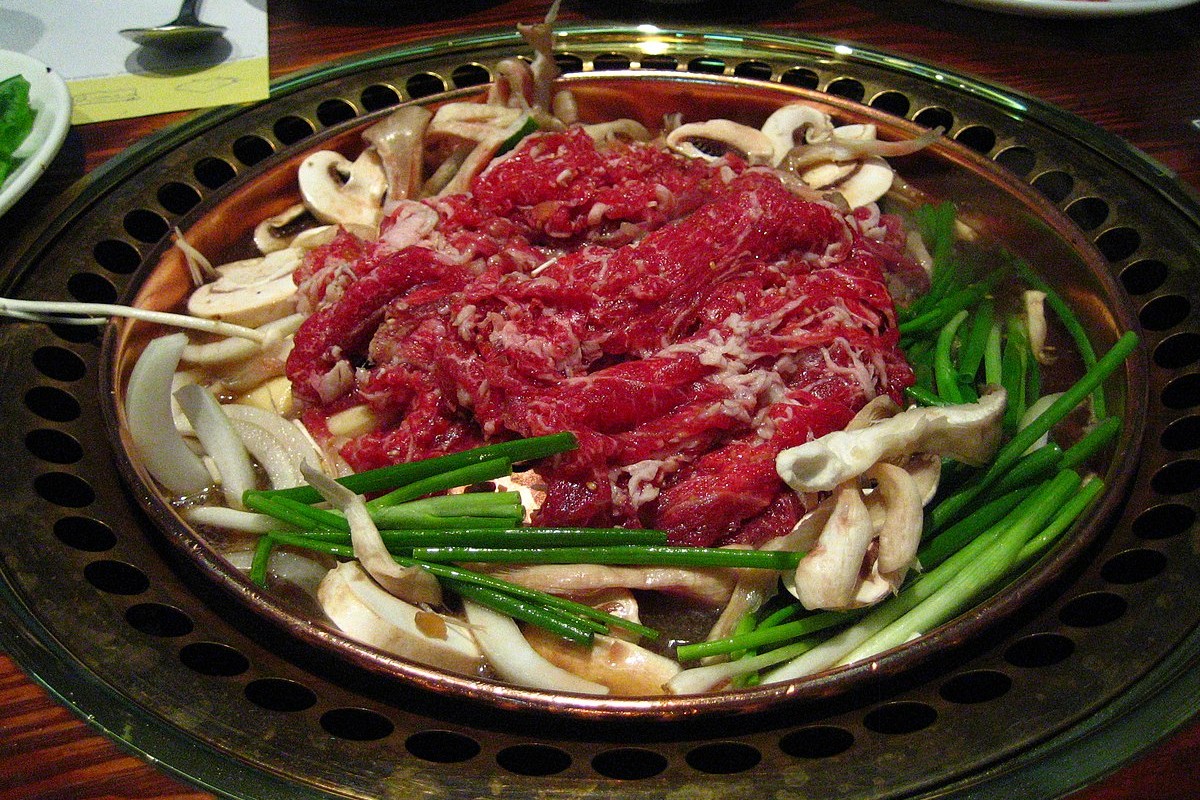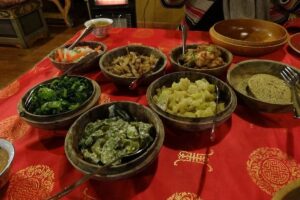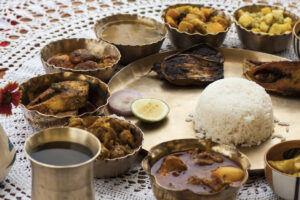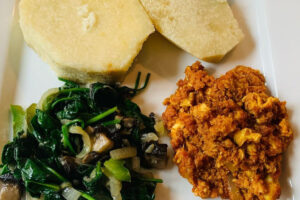South Korean cuisine is a captivating blend of bold flavors, vibrant colors, and nourishing ingredients. Rooted in tradition yet constantly evolving, Korean food offers a delightful culinary experience for every palate. From the iconic Bibimbap to the heartwarming stews, let’s dive into the heart of South Korea’s culinary scene and explore the dishes that have captured the hearts (and stomachs) of people worldwide.
1. Bibimbap: A Symphony of Colors and Flavors
Description:
Bibimbap, meaning “mixed rice,” is a visually stunning and nutritionally balanced dish. It features a bed of warm white rice topped with an array of colorful vegetables, seasoned meat (often beef), a fried egg, and a dollop of gochujang (red chili pepper paste). All the ingredients are mixed together before eating, creating a harmonious blend of flavors and textures.
Recipe:
https://www.nationalgeographic.com/travel/article/bibimbap-koreas-famous-dish
Key Ingredients:
Rice, assorted vegetables (spinach, bean sprouts, carrots, zucchini, mushrooms), beef (or other protein), egg, gochujang (red chili pepper paste), sesame oil.
Popular Restaurant:
Gogung in Seoul (highly rated for its traditional Bibimbap)
2. Bulgogi: The Beloved Marinated Beef
Description:
Bulgogi, meaning “fire meat,” is thinly sliced beef marinated in a sweet and savory sauce made with soy sauce, sugar, garlic, ginger, and sesame oil. It’s often grilled at the table on a hot plate or pan, resulting in tender, flavorful meat with a slight char.
Recipe:
https://thestayathomechef.com/korean-beef-bulgogi/
Key Ingredients:
Beef (usually sirloin or ribeye), soy sauce, sugar, garlic, ginger, sesame oil, black pepper, green onions.
Popular Restaurant:
Byeokje Galbi in Seoul (renowned for its high-quality Bulgogi)
3. Samgyeopsal: The Social Barbecue Experience
Description:
Samgyeopsal is more than just a dish; it’s a social experience. Thick slices of pork belly are grilled at the table and enjoyed with lettuce wraps, an array of side dishes (banchan), dipping sauces (like ssamjang), and soju (Korean alcohol). The sizzling sound, the aroma of grilling meat, and the communal aspect of sharing make it a beloved Korean pastime.
Recipe:
https://asiantoprecipes.weebly.com/8203-samgyeopsal-493404421749332-korean-pork-belly.html#
Key Ingredients:
Pork belly, lettuce, garlic, ssamjang (soybean paste dipping sauce), kimchi, other banchan (side dishes).
Popular Restaurant:
Saemaeul Sikdang (multiple locations) – a popular chain known for its affordable and delicious Samgyeopsal
4. Kimchi Jjigae (Kimchi Stew): A Spicy Staple
Description:
Kimchi Jjigae is a staple in Korean homes, a fiery and flavorful stew that embodies the essence of Korean flavors. This bubbling pot of goodness features fermented kimchi, tofu, pork belly, and vegetables simmered in a spicy broth. It’s a hearty and comforting dish that’s perfect for chilly days or any time you crave a bit of heat.
Recipe:
https://www.koreanbapsang.com/kimchi-jjigae-kimchi-stew/
Key Ingredients:
Kimchi, pork belly, tofu, onions, green onions, garlic, gochujang (red chili pepper paste), Korean chili flakes, anchovy broth.
Popular Restaurant:
Eunju Jeong in Seoul (known for its delicious Kimchi Jjigae and home-style Korean cuisine)
5. Doenjang Jjigae (Soybean Paste Stew): Savory Umami Goodness
Description:
Doenjang Jjigae is another beloved Korean stew, featuring a savory broth made with doenjang (fermented soybean paste). This umami-rich stew often includes vegetables like zucchini, potatoes, onions, mushrooms, and tofu, along with seafood or beef. It’s a nourishing and deeply flavorful dish that exemplifies the versatility of Korean fermented ingredients.
Recipe:
https://www.koreanbapsang.com/doenjang-jjigae-korean-soy-bean-paste/
Key Ingredients:
Doenjang (soybean paste), vegetables, tofu, seafood (anchovies, shrimp) or beef, garlic, green onions, chili pepper.
Popular Restaurant:
Sigol Bapsang in Seoul (offers a traditional and authentic Doenjang Jjigae)
6. Sundubu Jjigae (Soft Tofu Stew): A Soft and Spicy Delight
Description:
Sundubu Jjigae is a soft tofu stew known for its silky smooth texture and fiery kick. Uncurdled soft tofu is simmered in a spicy broth with vegetables, seafood (often clams or shrimp), beef, or pork. A raw egg is cracked into the stew just before serving, adding richness and another layer of texture.
Recipe:
https://mykoreankitchen.com/sundubu-jjigae/
Key Ingredients:
Soft tofu, seafood (clams, shrimp) or beef/pork, egg, vegetables (mushrooms, onions, zucchini), gochujang (red chili pepper paste), Korean chili flakes, garlic, anchovy broth.
Popular Restaurant:
BCD Tofu House (multiple locations) – a popular chain specializing in Sundubu Jjigae.
7. Galbi Jjim (Braised Short Ribs): Melt-in-Your-Mouth Goodness
Description:
Galbi Jjim is a hearty and satisfying dish featuring tender, fall-off-the-bone beef short ribs braised in a sweet and savory soy-based sauce. The ribs are cooked until incredibly tender, absorbing the flavors of garlic, ginger, onions, and Korean pear. It’s a popular dish for celebrations and gatherings, often enjoyed with steamed rice and side dishes.
Recipe:
https://www.koreanbapsang.com/galbijjim-korean-braised-beef-short/
Key Ingredients:
Beef short ribs, soy sauce, sugar, Korean pear, onions, garlic, ginger, sesame oil, rice wine.
Popular Restaurant:
Gangnam Myeonok in Seoul (a local favorite known for its melt-in-your-mouth Galbi Jjim)
8. Seolleongtang (Ox Bone Soup): A Nourishing Broth
Description:
Seolleongtang is a milky-white bone broth soup made by simmering ox bones for hours, resulting in a rich and deeply flavorful broth. The soup is typically served with thin slices of beef, rice noodles, and a side of chopped green onions, salt, and pepper for seasoning. It’s a popular dish for breakfast or lunch, known for its comforting and nourishing properties.
Recipe:
https://stellanspice.com/ox-bone-soup/
Key Ingredients:
Ox bones, beef (usually brisket or shank), rice noodles, green onions, salt, pepper.
Popular Restaurant:
Imun Seolleongtang in Seoul (a longstanding establishment famous for its Seolleongtang)
9. Samgyetang (Ginseng Chicken Soup): A Healthy Delight
Description:
Samgyetang is a nourishing chicken soup traditionally enjoyed in the summer months. A whole young chicken is stuffed with glutinous rice, garlic, jujubes, and ginseng, then simmered in a broth until tender. It’s a wholesome and restorative dish believed to boost energy and improve overall health.
Recipe:
https://www.maangchi.com/recipe/samgyetang
Key Ingredients:
Whole young chicken, glutinous rice, garlic, jujubes, ginseng, Korean dates, ginger, green onions.
Popular Restaurant:
Tosokchon Samgyetang in Seoul (a popular tourist destination known for its Samgyetang)
10. Haemul Jeongol (Seafood Hot Pot): A Bountiful Seafood Feast
Description:
Haemul Jeongol is a seafood lover’s dream come true. This hearty hot pot is brimming with fresh seafood like shrimp, mussels, clams, octopus, and fish, along with vegetables and a flavorful broth. It’s a communal dish often enjoyed with friends and family, and it’s perfect for warming you up on a cold day.
Recipe:
https://www.koreanbapsang.com/haemul-jeongol-spicy-seafood-hot-pot/
Key Ingredients:
Assorted seafood (shrimp, mussels, clams, octopus, fish), vegetables (mushrooms, onions, napa cabbage), tofu, gochujang (red chili pepper paste), Korean chili flakes, garlic, anchovy broth.
Popular Restaurant:
Busan Jib in Seoul (known for its delicious Haemul Jeongol and other seafood specialties)
Conclusion
This culinary journey has offered just a taste of the incredible diversity and flavor that South Korean cuisine has to offer. From the bustling street food markets to the refined Michelin-starred restaurants, there’s something to delight every palate and every budget. Explore beyond these classics and discover the regional specialties and hidden culinary gems that make Korea a food lover’s paradise. Let your taste buds guide you and enjoy the endless possibilities of Korean cuisine!
Let me know if you’d like to explore any of these dishes in more detail or have any other questions about Korean food.




